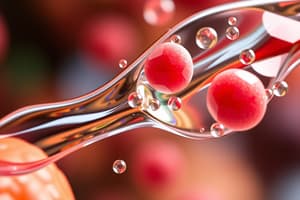Podcast
Questions and Answers
Which of the following is an example of facilitated diffusion?
Which of the following is an example of facilitated diffusion?
- Diffusion of water across a membrane
- Active transport of ions across a membrane
- Diffusion of glucose across a membrane (correct)
- Endocytosis of large molecules into a cell
What is the net result of osmosis?
What is the net result of osmosis?
- Diffusion of solutes out of a cell
- Active transport of water across a membrane
- Diffusion of water into a cell (correct)
- No net movement of water
What limits the speed of facilitated diffusion?
What limits the speed of facilitated diffusion?
- The presence of ATP
- The concentration gradient across the membrane
- The size of the molecules being transported
- The number of channel proteins (correct)
In primary active transport, where is energy used to induce transport?
In primary active transport, where is energy used to induce transport?
What is the purpose of endocytosis and exocytosis?
What is the purpose of endocytosis and exocytosis?
Which of the following is a key component of the laboratory's responsibility in ensuring accuracy and reproducibility of test results?
Which of the following is a key component of the laboratory's responsibility in ensuring accuracy and reproducibility of test results?
How is accuracy established when a new method is introduced for the first time?
How is accuracy established when a new method is introduced for the first time?
What is the range within which approximately 66% of points fall, based on the mean and standard deviation?
What is the range within which approximately 66% of points fall, based on the mean and standard deviation?
What is the range within which approximately 95% of points fall, based on the mean and standard deviation?
What is the range within which approximately 95% of points fall, based on the mean and standard deviation?
What is the purpose of a Levey-Jennings chart in the quality control process?
What is the purpose of a Levey-Jennings chart in the quality control process?
Which one of these formulas represents the sensitivity of a test?
Which one of these formulas represents the sensitivity of a test?
What is the Positive Predictive Value (PPV) of a test?
What is the Positive Predictive Value (PPV) of a test?
What is the False Positive Rate (FPR) of a test?
What is the False Positive Rate (FPR) of a test?
What is the Negative Predictive Value (NPV) of a test?
What is the Negative Predictive Value (NPV) of a test?
What is the formula for calculating the efficiency of a test?
What is the formula for calculating the efficiency of a test?
Which of the following is true about Westgard Rule 2?
Which of the following is true about Westgard Rule 2?
Which of the following is true about Westgard Rule 4?
Which of the following is true about Westgard Rule 4?
According to Westgard Rule 5, when should a run be rejected?
According to Westgard Rule 5, when should a run be rejected?
According to Westgard Rule 6, when should a run be rejected?
According to Westgard Rule 6, when should a run be rejected?
What is the minimum number of individuals required to construct a reference interval?
What is the minimum number of individuals required to construct a reference interval?
Which organelle is responsible for synthesizing lipids and carbohydrates?
Which organelle is responsible for synthesizing lipids and carbohydrates?
Which organelle is involved in lysosome and peroxisome synthesis?
Which organelle is involved in lysosome and peroxisome synthesis?
What is the main function of lysosomes?
What is the main function of lysosomes?
What is the toxic byproduct produced by peroxisomes?
What is the toxic byproduct produced by peroxisomes?
What is the main function of mitochondria?
What is the main function of mitochondria?
Which of the following is NOT a function of the nucleus?
Which of the following is NOT a function of the nucleus?
Which of the following is NOT a component of the plasma membrane?
Which of the following is NOT a component of the plasma membrane?
Which organelle is responsible for coordinating the interaction of mRNA and ribosomes to build polypeptides during protein synthesis?
Which organelle is responsible for coordinating the interaction of mRNA and ribosomes to build polypeptides during protein synthesis?
Which organelle is composed of two subunits, the small ribosomal subunit, and the large ribosomal subunit?
Which organelle is composed of two subunits, the small ribosomal subunit, and the large ribosomal subunit?
Which type of ribosomes are scattered through the cytoplasm?
Which type of ribosomes are scattered through the cytoplasm?
Which of the following is NOT a function of the nucleus?
Which of the following is NOT a function of the nucleus?
Which component of the plasma membrane is responsible for cell-to-cell communication?
Which component of the plasma membrane is responsible for cell-to-cell communication?
Which organelle is responsible for protein synthesis in a cell?
Which organelle is responsible for protein synthesis in a cell?
What is the function of free ribosomes in a cell?
What is the function of free ribosomes in a cell?
Which of the following is NOT a component of the nucleus?
Which of the following is NOT a component of the nucleus?
Flashcards are hidden until you start studying




